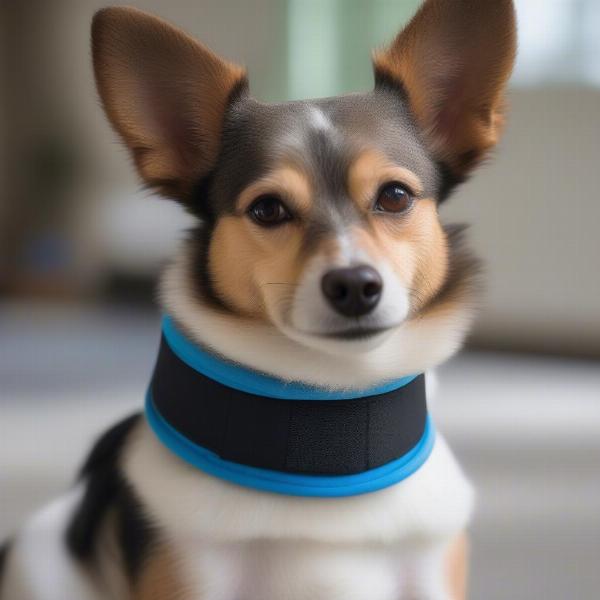A dog neck brace, also known as a cervical collar or e-collar, can be a crucial tool in helping your furry friend recover from a neck injury or surgery. While it might seem like a simple device, understanding the different types, proper usage, and potential challenges of a dog neck brace is essential for ensuring your dog’s comfort and well-being. This guide will cover everything you need to know about dog neck braces, from choosing the right type to managing your dog’s recovery.
Choosing the right neck brace for your dog depends on the specific condition being treated. There are two main types: soft and rigid. Soft braces offer mild support and are often used for minor strains or sprains. Rigid braces provide more substantial immobilization and are typically prescribed after surgery or for more serious injuries.  Dog Wearing Soft Neck Brace Your veterinarian will recommend the best type of brace based on your dog’s individual needs.
Dog Wearing Soft Neck Brace Your veterinarian will recommend the best type of brace based on your dog’s individual needs.
Understanding the Different Types of Dog Neck Braces
Soft Braces
Soft braces offer comfort and flexibility, making them suitable for less severe neck injuries. They often resemble a padded neck pillow and provide gentle support. These braces are generally used for minor strains, sprains, or to limit head movement after certain procedures.
Rigid Braces
Rigid braces offer greater stability and immobilization. They are commonly used after neck surgery or for more serious injuries like intervertebral disc disease (IVDD). These braces restrict head and neck movement more effectively than soft braces. The increased support is vital for proper healing and pain management.
How to Properly Fit and Use a Dog Neck Brace
Proper fit is crucial for a dog neck brace to be effective. A poorly fitted brace can be uncomfortable and even worsen your dog’s condition. Your veterinarian will measure your dog’s neck and guide you on the correct size and adjustment. It’s important to monitor your dog closely for any signs of discomfort, chafing, or sores. Regular checks and adjustments are necessary, especially as your dog heals and their neck size may change.
Monitoring Your Dog While Wearing a Neck Brace
While your dog is wearing a neck brace, it’s important to monitor their behavior and overall condition. Look out for any changes in eating, drinking, or bathroom habits. If you notice any signs of discomfort or distress, contact your veterinarian immediately.
Common Questions about Dog Neck Braces
While a neck brace can be an effective tool for recovery, it’s essential to address common concerns and challenges. Understanding these potential issues can help you prepare for your dog’s needs during their recovery period.
1. How long will my dog need to wear a neck brace? The duration varies depending on the specific condition and your dog’s individual healing process. It could range from a few weeks to several months. Your veterinarian will determine the appropriate timeframe.
2. Can my dog eat and drink with a neck brace on? Yes, most dogs can eat and drink normally with a brace. However, you might need to adjust their food and water bowls to a more accessible height.
3. How do I keep my dog’s neck brace clean? Regular cleaning is essential to prevent infection and discomfort. Follow your veterinarian’s instructions for cleaning the specific type of brace your dog is wearing.
4. What are the signs of a poorly fitting neck brace? Sores, chafing, excessive scratching, or reluctance to wear the brace can indicate a poor fit. Consult your veterinarian if you notice any of these signs.
5. Can my dog sleep with a neck brace on? In most cases, yes. The brace helps stabilize the neck and may even improve sleep quality for dogs recovering from injuries.
6. Will my dog be uncomfortable wearing a neck brace? Initially, some dogs might experience slight discomfort adjusting to the brace. However, it’s crucial to remember the brace is aiding their recovery and managing pain.
7. Are there any alternatives to a neck brace? In some cases, alternative treatments like physical therapy or medication might be considered. Your veterinarian will recommend the best course of action for your dog.
Conclusion
A dog neck brace can be a vital tool in your dog’s recovery journey. Understanding the different types, proper usage, and potential challenges associated with dog neck braces is essential for ensuring your furry friend’s comfort and well-being throughout the healing process. Always consult with your veterinarian for personalized advice and guidance on choosing and using a neck brace for your dog.
ILM Dog is a leading international pet website dedicated to providing expert advice and resources on all aspects of dog care. From breed selection and health to training, nutrition, and grooming, we offer a comprehensive guide to help you provide the best care for your canine companion. We also cover specialized areas such as puppy care, senior dog care, and traveling with dogs. For expert advice and personalized recommendations, contact us at [email protected] or call us at +44 20-3965-8624. ILM Dog is your trusted source for reliable and practical information on all things dog-related.